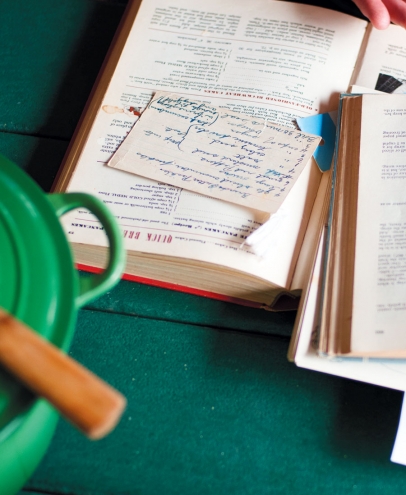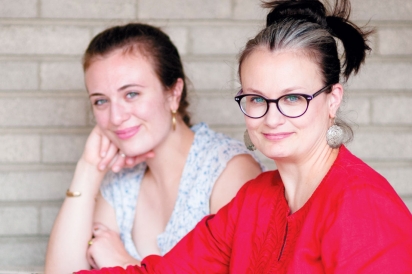Raising a Locavore: A Mother-Daughter Story
The low point, for Emily Grazier, looked like boxed crackers with spice mix on top, a.k.a. dinner, her freshman year at St. John’s College. Craving the flavorful food of her childhood, unsatisfied with cafeteria fare, she “cooked” up a well-seasoned (if dry) solution. Then, resolved to do better. Three years later, the cracker’s a wry memory.
The oldest of three girls, 20-year-old Emily grew up in a home where food came first. The sourcing. The cooking. The eating. The gathering. Lisa Clark, Emily’s mother and longtime Columbus resident, knew no other way.
“I was raised all over,” Lisa recounts, by college-student parents whose itinerant lives never compromised their deeply held food philosophies. Even as 1960s America’s infatuation with convenience exploded, “we always ate seasonally,” Lisa recalls, purchasing produce from Syracuse, New York, farmers markets, rarely eating citrus in summer, and patronizing small, family-owned grocers. “No one ate the way we did,” she reports. With hindsight’s mix of empathy and irony, she remembers lecturing a friend’s mother on the evils of hot dogs, at age 8. “I wasn’t invited back,” she adds, grinning, and acknowledging diplomacy was a double-digit skill.
From her parents, Lisa learned invaluable, practical lessons. Her scientist-mother taught “the lost art of cooking with cleanliness,” from proper preparation of raw meats and produce, to starting always with a hot, sudsy sink. “Baking is like chemistry class: follow exactly and you can’t go wrong. Cooking, however, is improvisation.” Lisa’s father excelled equally, differently. Influenced by Child, Pepin, Beard, “his cooking was a mad whirlwind that took an entire night to clean up, but was totally amazing.”
Keen bonds with grandparents, both sets with still-strong ties to the land, reinforced Lisa’s food learning. She spent summers on her Swedish grandmother’s farmstead, preserving the bounty, “from strawberries to grapes.” Her grandmother’s cookbooks still hold pride of place on her shelf, including the Swedish sausage recipe, inscribed in spidery script on the endpaper, that begins “16# pork… .”
Even today, conversation between Lisa and Emily is regularly interrupted by fond, smile-prompting mentions of fruit soup, Swedish coffee cake, and a treasured family soup whose dried yellow peas must be specially ordered. And, every year, are. Little surprise, then, that Lisa returns time and again to her conviction that “good food is available for all.” And entered adulthood with a deep-seated respect for food’s origins and impact. A respect she’s powerfully instilled in her children.
“Most of my earliest memories are about food,” recalls Emily, the oldest of Lisa’s three daughters. With a wide smile, Emily remembers “eating the ends of warm bread.” From a tofu recipe “written” at age 2 (“just scribbles, but I still have it!” Lisa laughs), Emily began baking in earnest around age 8, “muffins, pancakes, the basics,” appreciating the clear instructions and delicious results, alike. Within a few years, she was cooking “alongside, or under direction:” salsa, pesto, garden fare.
Meanwhile, Emily was learning the true value of food. Homeschooling, her mother points out, integrated this vital lesson into her daughters’ days. They were right alongside as Lisa sussed out Columbus’ best, and devoted precious food dollars to treasured, trusted vendors. Bluescreek Meats, North Market Poultry, farmers markets, without fail: Lisa’s girls learned, week in, week out, the how, where, and why of good food.
Enough so, that the summer before college, Emily worked to buy a Chemex coffee maker. Enough so, that instead of gaining the traditional Freshman Fifteen, Emily lost the same, following a year of cafeteria fare. (“I didn’t recognize her,” Lisa marvels, remembering a freshman photo. This, despite bi-monthly care packages from home, packed with jam, bread, granola, and other comforts.) Enough so, that “one of the first things I did was find a farmers market, within walking distance,” Emily recalls. She went every week. Still does. And has convinced countless friends to follow suit.
Indeed, adopting a farmers market is just one genius tip Emily offers. Ask what lessons she’d share with new students and Emily’s advice is so sound, so sage, it ought to be handed to every incoming freshman. “Cook from scratch. Source locally. Cook simply. Use spices. Invest in quality.” Ingredients and equipment, both.
“Just because you’re a college student, doesn’t mean you can’t eat well. A little well-sourced food goes a long way!” Likewise, Emily stresses the value of a few good tools, pointing out that one well-seasoned cast-iron skillet is worth any number of cheap, lightweight “college” pans. Learn techniques, she emphasizes. Knife skills, basic methods, cooking fundamentals. Then, practice, practice, practice. And finally, and perhaps first and foremost, Emily stresses the importance of cooking with people. Of gathering, together, at table. “Even if they didn’t want to participate, I’d ask friends to just sit and study while I cooked. They helped with the dishes. We ate together. It helped build this amazing community.”
A community that stretches well beyond Emily’s kitchen table, to St. John’s entire student body. Since freshman year, when work-study offered a food blogging partnership with the Dining Hall’s renowned executive chef, Emily has written “Formaggio Elettrico: Randall Hall at St. John’s College Food Blog” (gastrokitty.blogspot.com). Part information clearinghouse (think menus and hours), part first-person student’s perspective on independent eating and cooking, Gastrokitty’s a forum for Emily to explore her passion for food. Reviewing everything from restaurants to caviar, recounting student “family” Thanksgivings and red beans and rice’s humble glories, Emily serves up a lively mix of recipes, anecdotes, resources, and recommendations, underscored always by a true cook’s wisdom, and the curiosity of one hungry for the world.
A wisdom and hunger clearly rooted in her childhood; her mother, Lisa’s, kitchen; and the countless generations who laid the foundation for a lifelong love of good, fresh, local food.







